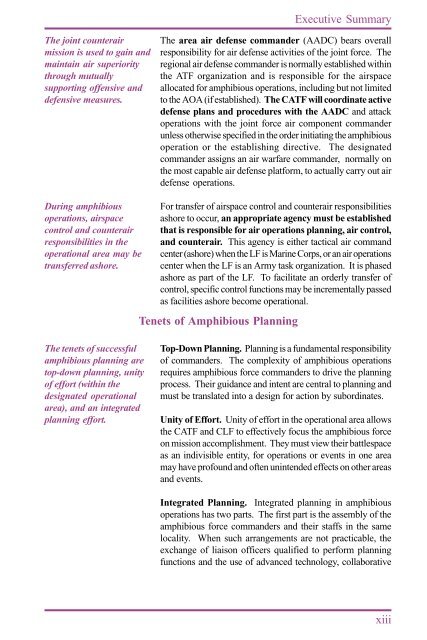Joint Doctrine for Amphibious Operations - Historic Naval Ships ...
Joint Doctrine for Amphibious Operations - Historic Naval Ships ...
Joint Doctrine for Amphibious Operations - Historic Naval Ships ...
- No tags were found...
Create successful ePaper yourself
Turn your PDF publications into a flip-book with our unique Google optimized e-Paper software.
Executive SummaryThe joint counterairmission is used to gain andmaintain air superioritythrough mutuallysupporting offensive anddefensive measures.The area air defense commander (AADC) bears overallresponsibility <strong>for</strong> air defense activities of the joint <strong>for</strong>ce. Theregional air defense commander is normally established withinthe ATF organization and is responsible <strong>for</strong> the airspaceallocated <strong>for</strong> amphibious operations, including but not limitedto the AOA (if established). The CATF will coordinate activedefense plans and procedures with the AADC and attackoperations with the joint <strong>for</strong>ce air component commanderunless otherwise specified in the order initiating the amphibiousoperation or the establishing directive. The designatedcommander assigns an air warfare commander, normally onthe most capable air defense plat<strong>for</strong>m, to actually carry out airdefense operations.During amphibiousoperations, airspacecontrol and counterairresponsibilities in theoperational area may betransferred ashore.For transfer of airspace control and counterair responsibilitiesashore to occur, an appropriate agency must be establishedthat is responsible <strong>for</strong> air operations planning, air control,and counterair. This agency is either tactical air commandcenter (ashore) when the LF is Marine Corps, or an air operationscenter when the LF is an Army task organization. It is phasedashore as part of the LF. To facilitate an orderly transfer ofcontrol, specific control functions may be incrementally passedas facilities ashore become operational.Tenets of <strong>Amphibious</strong> PlanningThe tenets of successfulamphibious planning aretop-down planning, unityof ef<strong>for</strong>t (within thedesignated operationalarea), and an integratedplanning ef<strong>for</strong>t.Top-Down Planning. Planning is a fundamental responsibilityof commanders. The complexity of amphibious operationsrequires amphibious <strong>for</strong>ce commanders to drive the planningprocess. Their guidance and intent are central to planning andmust be translated into a design <strong>for</strong> action by subordinates.Unity of Ef<strong>for</strong>t. Unity of ef<strong>for</strong>t in the operational area allowsthe CATF and CLF to effectively focus the amphibious <strong>for</strong>ceon mission accomplishment. They must view their battlespaceas an indivisible entity, <strong>for</strong> operations or events in one areamay have profound and often unintended effects on other areasand events.Integrated Planning. Integrated planning in amphibiousoperations has two parts. The first part is the assembly of theamphibious <strong>for</strong>ce commanders and their staffs in the samelocality. When such arrangements are not practicable, theexchange of liaison officers qualified to per<strong>for</strong>m planningfunctions and the use of advanced technology, collaborativexiii
















